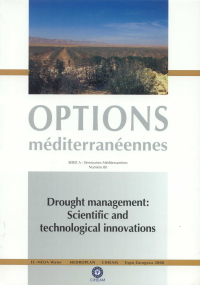| Article précédent | p. 349-352 | Article suivant |
Assessment of the impact of climate change on olive growing in Tunisia using GIS tools
During the 1999-2002 period olive growing faced a very severe drought in Tunisia. The rainfall deficit reached in some regions more than 50% of the normal amount. In order to quantify the drought effects, a severity scale was established. This scale was based on plant status and has three levels which are: 1- normal state, 2- growth halt without vanishing and 3- wilting. Using this scale and field investigations the map of olive trees reaction to drought was drawn for all Tunisian olive groves. The regional maps of severity and rainfall deficit did not show a good superposition. On the other hand, a good superposition was observed between olive reaction and plantation ages maps. Thus, under the same drought conditions, the senescent orchards are less resistant.
L'oléiculture tunisienne a été confrontée durant la période 1999-2002 à une sécheresse sévère. Le déficit pluviométrique durant cette période a atteint 50% de la normale. Afin de quantifier les effets de la sécheresse sur l'oliveraie tunisienne, une échelle d'affection des plantations a été établie. Cette échelle comprend trois niveaux : 1- état normal, 2- arrêt de la croissance végétative sans flétrissement et 3- flétrissement ou dessèchement. En se basant sur cette échelle et sur une enquête de terrain, une carte nationale de l'affection de l'oliveraie par la sécheresse a été établie. Par ailleurs, nous n'avons pas observé une bonne superposition des cartes de la sévérité de l'affection et du déficit hydrique. Par contre, une meilleure superposition a été obtenue pour les cartes d'affection et de sénescence des oliviers. De ce fait, l'âge des plantations semble être un facteur primordial de la résistance de l'olivier au déficit hydrique.
- [ Afficher ]
- [ Télécharger ]
- [ Exporter la citation ]
Vous pouvez télécharger la citation au format :
- [ Imprimer ]
-
Mots-clés
EVALUATION DE L'IMPACT, OLEA EUROPAEA, PLANTATIONS, RESISTANCE A LA SECHERESSE, SECHERESSE, SYSTEME D'INFORMATION GEOGRAPHIQUE, TUNISIECiter cet article
Gargouri K., Rhouma A., Sahnoun A., Ghribi M., Bentaher H., Ben Rouina B., Ghrab M. Assessment of the impact of climate change on olive growing in Tunisia using GIS tools. In : López-Francos A. (ed.). Drought management: scientific and technological innovations. Zaragoza : CIHEAM, 2008. p. 349-352. (Options Méditerranéennes : Série A. Séminaires Méditerranéens; n. 80). 1. International Conference Drought Management: Scientific and Technological Innovations, 2008/06/12-14, Zaragoza (Spain). http://om.ciheam.org/om/pdf/a80/00800462.pdf



